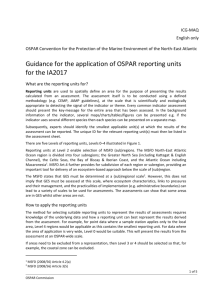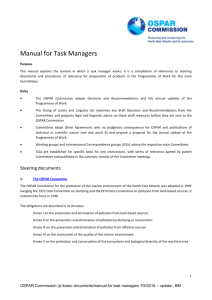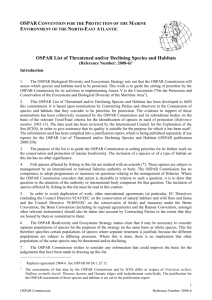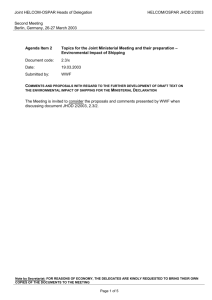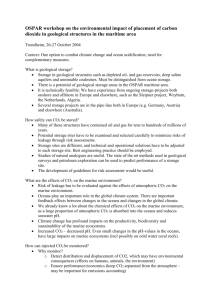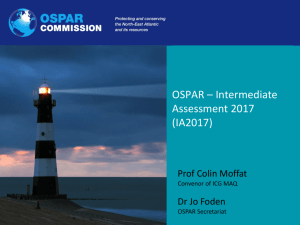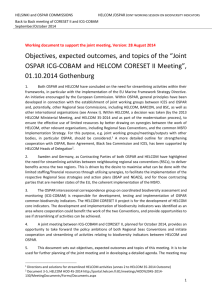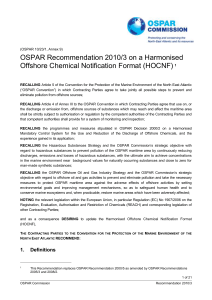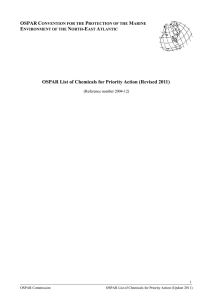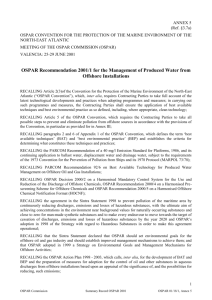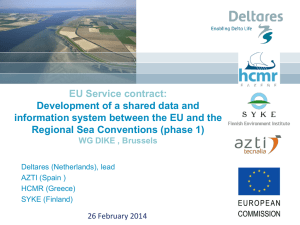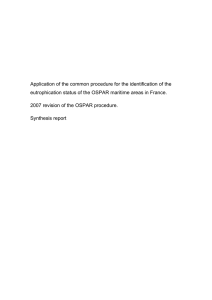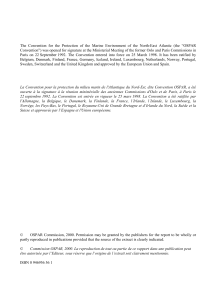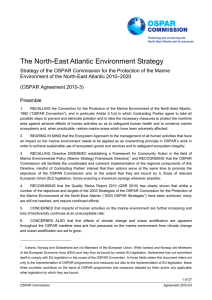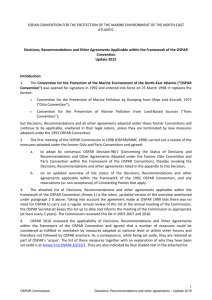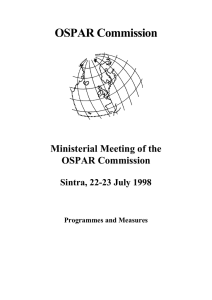Assessment sheet guidance
advertisement
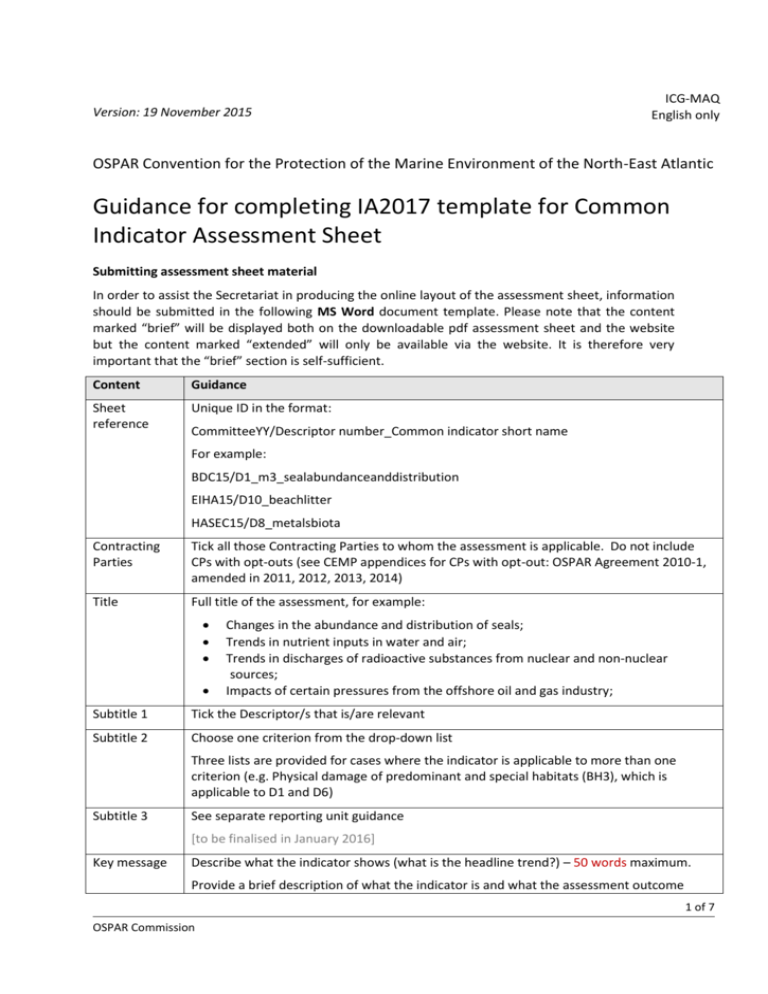
Version: 19 November 2015 ICG-MAQ English only OSPAR Convention for the Protection of the Marine Environment of the North-East Atlantic Guidance for completing IA2017 template for Common Indicator Assessment Sheet Submitting assessment sheet material In order to assist the Secretariat in producing the online layout of the assessment sheet, information should be submitted in the following MS Word document template. Please note that the content marked “brief” will be displayed both on the downloadable pdf assessment sheet and the website but the content marked “extended” will only be available via the website. It is therefore very important that the “brief” section is self-sufficient. Content Guidance Sheet reference Unique ID in the format: CommitteeYY/Descriptor number_Common indicator short name For example: BDC15/D1_m3_sealabundanceanddistribution EIHA15/D10_beachlitter HASEC15/D8_metalsbiota Contracting Parties Tick all those Contracting Parties to whom the assessment is applicable. Do not include CPs with opt-outs (see CEMP appendices for CPs with opt-out: OSPAR Agreement 2010-1, amended in 2011, 2012, 2013, 2014) Title Full title of the assessment, for example: Changes in the abundance and distribution of seals; Trends in nutrient inputs in water and air; Trends in discharges of radioactive substances from nuclear and non-nuclear sources; Impacts of certain pressures from the offshore oil and gas industry; Subtitle 1 Tick the Descriptor/s that is/are relevant Subtitle 2 Choose one criterion from the drop-down list Three lists are provided for cases where the indicator is applicable to more than one criterion (e.g. Physical damage of predominant and special habitats (BH3), which is applicable to D1 and D6) Subtitle 3 See separate reporting unit guidance [to be finalised in January 2016] Key message Describe what the indicator shows (what is the headline trend?) – 50 words maximum. Provide a brief description of what the indicator is and what the assessment outcome 1 of 7 OSPAR Commission shows. This should be a non-technical, non-scientific description for a general or policy audience. Background (brief) A clear introduction to the topic – 250 words maximum. Provide a brief non-technical, non-scientific introduction to the indicator, for a general audience. This should include: A description of the indicator. Include reference to OSPAR agreement if applicable Description of the key drivers or pressures Provide any images appropriate to the background (brief) section (photo, illustration). Reference the image using the filename at the bottom of the background (brief) section; e.g. Filename: Whelks_photo.jpg (see “Additional guidance for completion” notes at the end of this document for figure/table numbering) Background (extended) Provide any additional background information. No word limit. Identify the location of figures/tables/formulae within the body text by using the caption and filename; (for numbering see “Additional guidance for completion” notes at the end of this document) e.g. Figure a: OSPAR assessment using data extracted from DOME on 31 October 2013 http://dome.ices.dk/osparmime/main.html (Filename: Figure_a_OnlineAssessTool.jpg) Table a: Assessment criteria used in the CEMP data assessment (Table_a_Assess_Criteria.xls) Formula a: Calculation of annual index (filename: Formula_a.jpg) Include citation with references at the end of the body text (see Additional guidance notes below for reference list style); e.g. Law, R.J., Bolam, T., James, D., Barry, J., Deaville, R., Reid, R.J., Penrose, R., Jepson, P.D. 2012. Butyltin compounds in liver of harbour porpoises (Phocoena phocoena) from the UK prior to and following the ban on the use of tributyltin in antifouling paints (19922005 & 2009). Marine Pollution Bulletin 64, 2576-2580 Background (figures & tables) Assessment Method including assessment values where available1 (extended) 1 List of figures/charts/tables/images filenames that have been referenced in the ‘Background (extended)’. For example: Seals_photo.jpg Kelp_photo_Oceana.jpg Figure_a_MapOfAssessArea.jpg Table_a_Assess_Criteria.xls Formula_a.jpg A description of the methods used to calculate the indicator and deliver the assessment. For example, method description, data collation, aggregation and analysis. If information resides externally, provide URL links to the underlying guidelines, assessments, methods, etc. In some cases the method of assessment for the indicator will follow published methods for the main part. However, there may be deviation from these methods for the presentation of the common indicator. Any differences in methods should be clearly Revised on basis of CoG (2) 2015 2 of 7 OSPAR Commission described. List any tables or figures including their filenames, and references. (for numbering see “Additional guidance for completion” notes at the end of this document) Results (brief) Describe the observed status of the indicator in assessed area and any change/trend/assessment outcome. For some common indicators the assessment will be against an assessment value (e.g. background concentration, abundance threshold value) The main section should total 450 words maximum and any figure/table. Please identify insertion location of any figures/tables by using caption and filename (for numbering see “Additional guidance for completion” notes at the end of this document). Results (extended) Provide any additional information regarding results. No word or figure/table limit. Include citations, with references at the end of the body text. Identify insertion location of any figures or tables by using the filename (for numbering see “Additional guidance for completion” notes at the end of this document) Results (figures & tables) List of figures/charts/maps/tables/images filenames that have been used in the “Results” and “Results (extended)” Conclusion (brief) Conclusion on the assessment of the indicator. Describe what the results of the assessment show, any conclusions/implications/limitations/confidence. This section 200 words maximum. The limitations and confidence of the indicator assessment should be described in language for a general and policy audience. Conclusion (extended) Any further conclusions/implications/limitations/confidence. No word limit. Include citations, with references at the end of the body text. This section should provide the detailed background to the “Conclusions (brief)”. The limitations and confidence in the assessment can be described in more scientific and technical terms. Knowledge gaps (brief) Brief description of any gaps in knowledge e.g. science gaps. This section 100 words maximum. Knowledge gaps (extended) Description of any gaps in knowledge e.g. science gaps. When describing knowledge and science gaps describe what work or studies would be needed to fill the gaps. The information in this and the previous sections will be used by the OSPAR Science needs Agenda (OSA) Task Group to inform future iterations of the OSA. Assessment Metadata Metadata are “data about the content, quality, condition, and other characteristics of data”2. The objective of collecting standardised metadata is to provide a structure for describing the assessment that has been carried out. Metadata define a core set of elements which explain the assessment from a technical perspective; increasing confidence, allowing reuse and enabling users to evaluate applicability of the assessment to external functions. An added asset is the facilitation of discovery and reuse of the assessment and its underlying data because of the increased documentation of its technical characteristics. 2 FGDC Content Standard for Digital Geospatial Metadata Workbook, Ver 2.0, May 1, 2000 3 of 7 OSPAR Commission Assessments will be handled in a semi-automated fashion; completion of the metadata and provision of associated files will allow the information to be uploaded and made available via the OSPAR Data and Information Management System (ODIMS). Greyed cells in ‘Explanation’ are to be completed by the Secretariat. Field Sheet reference Assessmen t type Data Type Text Explanation Value List Choose ‘Intermediate Assessment’ from the drop-down list provided by the Secretariat. Context (1) Value list Choose one thematic area from the drop-down list provided by the Secretariat. Context (2) Text OSPAR-relevant Publication, Decision, Recommendation or Other Agreement. Use the following naming protocols: [OSPAR Publication] [YYYY]-[publication number] [title] [OSPAR Recommendation] [YYYY]-[number] [title] [OSPAR Decision] [YYYY]-[number] [title] [OSPAR Agreement] [YYYY]-[number] [title] For example: OSPAR Publication 2008-379 CEMP Assessment Manual: Coordinated Environmental Monitoring Programme Assessment Manual for contaminants in sediment and biota OSPAR Recommendation 2015-04 on furthering the protection and conservation of the Allis shad (Alosa alosa) in Regions II, III and IV of the OSPAR maritime area OSPAR Decision 2012-1 on the establishment of the Charlie-Gibbs North High Seas Marine Protected Area OSPAR Agreement 2004-15 Provisional JAMP Assessment Criteria for TBT – Specific Biological Effects. Amendments agreed by ASMO 2008 Context (3) Value list Tick the Descriptor/s that is/are relevant Context (4) Value list Choose one criterion from the drop-down list provided by the Secretariat. Point of contact Email Metadata date Title Text Three lists are provided for cases where the indicator is applicable to more than one criterion (e.g. some biodiversity indicators) Lead author organisation / Individual name Text Date Point of contact email: organisation / Individual The date on which this metadata were completed Text Resource abstract Text Title of the assessment – title to match that given in the 3rd row of the main content (above) Brief summary of the content of the assessment (1 or 2 sentences) describing 4 of 7 OSPAR Commission Field Data Type Explanation what was done. This will be available as part of a search function in the OSPAR Assessment Tool, so include key words and conclusions. Weblinks to additional information about the assessment e.g. link to Publication, Decision, Recommendation, Agreements, common indicator agreement Where available links to other references, e.g. scientific journal papers, can be provided. The items in the list should be line-separated Linkage URL Topic category Value List Choose one from the drop-down list of INSPIRE categories. For most indicators this will be ‘Environment’ Indirect spatial reference Text Geographic scope of the assessment – applicable reporting unit code for each block assessed (TB defined) This will be the same information as listed in Assessment sheet content table, field “Subtitle 3 (extended)” N Lat E Lon S Lat W Lon Countries Number Number Number Number Text Tick all those Contracting Parties who contributed data to the assessment. Start date End date Date of publication Conditions applying to access and use Date Date Date (Temporal extent of assessment period) YYYY-MM-DD (Temporal extent of assessment period) YYYY-MM-DD URL T&Cs for assessment and data (e.g. OSPAR data Policy) In most cases this will be http://www.ospar.org/site/assets/files/1215/ospar_data_conditions_of_use.p df Lineage Data Snapshot Data Results URL URL Data Source URL Zip Name of Zip file containing the final results file(s) generated by the assessment e.g. shapefile, MS Excel spreadsheet Links to data sources used in assessment This may be to datasets hosted by ICES, OSPAR, etc. Additional Guidance for completion Figure/Table naming The numbering of the figures/tables/formulae/charts etc. in the “brief” sections, which form the two page print assessment sheet, will follow a Figure 1, Figure 2, Figure 3, etc. structure; For the online only “extended” sections, the figure/table numbering will follow a Figure a, Figure b, Figure c, Table a, Table b, etc. structure. Data snapshot 5 of 7 OSPAR Commission All data and any associated coding or script that have been applied to the data in order to run the assessment must be supplied in the final assessment package. These can be supplied in the native format, e.g. spreadsheets, databases, R code, Visual Basic script, in a single zip file, following the prescribed naming convention. This is required for transparency and forms part of the audit trail Figures – as images All supplied figures and supporting files must follow the described naming convention (TBC by Secretariat). To be supplied to the Secretariat in a zip file. Photos As jpeg A minimum of 2 photographs should be supplied and all photos must be fully accredited with permission for publication and online use. If no accreditation is necessary, please make this clear. Images must be at a resolution of 300dpi and in jpeg format – screenshots are not suitable Graphs As jpeg All graphs need to have clear, brief titles and be provided as a high resolution jpeg. All data used to make the graph must be supplied in Excel or readily accessible format Formulae As jpeg For example Tables As Excel file All tables need to have a clear, brief title. All data used to make the table must be supplied in Excel or readily accessible format Infographics As jpeg All infographics need to have a clear, brief title and be provided as a high resolution jpeg. All information used to make the infographic must be provided in a suitable and accessible format Maps As jpeg All maps need to have a clear, brief title. All background data used to make the maps, such as shapefiles, need to be supplied in the assessment snapshot data package Use of language Scientific names – try to avoid using scientific names if at all possible. If this is not possible, be consistent e.g. do not use scientific names in tables and common names in text. Scientific names can 6 of 7 OSPAR Commission be used in the extended online text, provided the common name is referenced in the first instance it is used. In translating between scientific and common names use the World Register of Marine Species, available from http://www.marinespecies.org/. Avoid acronyms or explain them – avoid the use of acronyms in the summary text, in the extended text they can be used but written in full in their first instance. Referencing No citations should be used in the 2 page assessment sheets; however they can be used in the extended online version and in underlying assessments. In the extended online version references should be placed at the end of the appropriate section using the following layouts for peer reviewed and grey literature publications respectively: Author, X.Y., Date YYYY, Title. Organisation or Journal, Location, Number of pages (e.g. 123 pp) or pages (12-15) Title. Organisation, Location, date YYYY. Publication Ref. Number of Pages 7 of 7 OSPAR Commission
